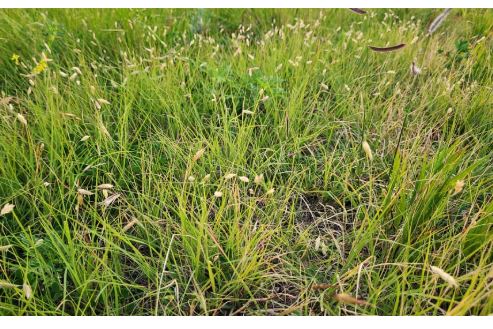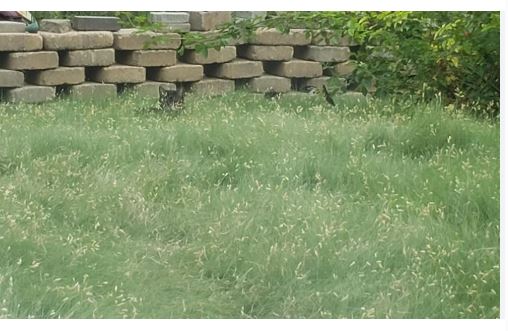
Buffalograss (Bouteloua dactyloides) is a warm-season, perennial shortgrass native to North America’s Great Plains, from Canada to Mexico. A keystone of prairie ecosystems, it spreads via stolons, forming a low, dense sod (3–12 inches unmowed) with fine to coarse blades (1–3.5 mm). It’s prized for drought tolerance and low maintenance, thriving in Zones 4–10.
Its gray-green to blue-green foliage reflects adaptation to arid climates, turning tan in dormancy below 50°F. Naturally dioecious (male/female plants), it varies in ploidy (diploid to hexaploid), influencing vigor and seed production. Hardy to -20°F, it prefers full sun and struggles in shade, making it ideal for open landscapes.
Buffalograss grows best in spring to summer (60°F–95°F) on well-drained, clay-rich soils (pH 6.0–7.5). Seeded at 4–8 lbs/1,000 sq ft or planted via sod/plugs, it spreads 12–45 cm/year, establishing in 6–24 months with 1 inch water weekly initially. Once mature, it survives on 12–25 inches rainfall annually, needing minimal care.
Uses range from low-input lawns and golf roughs to rangeland forage (3–6 tons DM/acre) and erosion control. Mow at 0.5–4 inches depending on purpose; it requires 1–2 lbs nitrogen/1,000 sq ft yearly and resists pests, though weeds challenge young stands. Its slow growth reduces mowing but delays full coverage.
Ecologically sustainable, buffalograss supports biodiversity and conserves water, tolerating heat up to 110°F and alkali soils. Its short stature and toughness suit xeriscaping, though cold above 6,500 ft and shade limit its range. From rustic pastures to manicured turfs, it’s a resilient, versatile grass.

Varieties of Buffalo Grass
Texoka Buffalograss
Texoka, released in 1974 by the USDA from Oklahoma and Texas ecotypes, has medium-coarse blades (2–3 mm wide), a gray-green color, and a vigorous stolon spread (15–45 cm/year). Reaching 6–12 inches unmowed, it’s diploid-tetraploid mixed, hardy to Zone 5 (-20°F). It thrives in full sun on clay-loam soils (pH 6.0–7.5), establishing in 1–2 seasons from seed (5–8 lbs/1,000 sq ft). Mow at 2–4 inches for forage (yielding 3–5 tons DM/acre) or 1–3 inches for turf; it needs 12–20 inches annual rainfall and 50–100 lbs nitrogen/acre. Drought and cold-tolerant, it’s used for rangeland and low-input lawns but has moderate weed resistance.
Sharp’s Improved Buffalograss
Sharp’s Improved, a 1980s Kansas selection, features medium blades (2–2.5 mm), a blue-green hue, and a dense, sod-forming habit (6–10 inches unmowed). A tetraploid, it’s hardy to Zone 5, growing in full sun on varied soils (pH 6.0–7.0). Seeded at 4–6 lbs/1,000 sq ft, it spreads 12–36 cm/year, maturing in 1–2 seasons. Mow at 1.5–3 inches; its finer texture suits lawns over Texoka, needing 0.5–1 inch water weekly and 1–2 lbs nitrogen/1,000 sq ft yearly. It tolerates drought and alkali but struggles in shade or heavy traffic.
609 Buffalograss
609, a vegetative tetraploid from Nebraska (1990s), has fine blades (1.5–2 mm), a dark green color, and a tight, low growth (4–8 inches unmowed). Hardy to Zone 6 (-10°F), it excels in full sun on clay soils (pH 6.0–6.5), spreading 15–30 cm/year from plugs or sod. Mow at 1–2 inches for premium turf; it needs 1 inch water weekly during establishment and 1–2 lbs nitrogen/1,000 sq ft annually. Drought-tolerant with good density, it’s ideal for lawns but suffers winterkill below 5,500 ft elevation and lacks shade tolerance.
Prairie Buffalograss
Prairie, a Texas A&M vegetative cultivar (1990s), boasts fine blades (1–1.5 mm), a vibrant green hue, and a dense, carpet-like form (4–6 inches unmowed). A hexaploid, it’s suited to Zones 7–9 (0°F–20°F), thriving in full sun on heavy soils (pH 6.0–7.0). Planted via plugs (12–18 inch centers), it spreads 15–45 cm/year, maturing in 6–12 months. Mow at 0.5–2 inches; it needs 0.5–1 inch water weekly and 1–2 lbs nitrogen/1,000 sq ft yearly. Drought and heat-tolerant, it’s a top lawn choice but cold-sensitive above 6,000 ft.
Legacy Buffalograss
Legacy, a Nebraska vegetative tetraploid (1998), has fine blades (1–2 mm), a dark blue-green color, and a lush, uniform growth (4–8 inches unmowed). Hardy to Zone 5, it grows in full sun to light shade (6–8 hours sunlight) on clay-loam (pH 6.0–6.5), spreading 15–30 cm/year from sod. Mow at 1–2 inches; it needs 0.5–1 inch water weekly and 1–2 lbs nitrogen/1,000 sq ft annually. Cold and drought-tolerant, it resists weeds well, making it ideal for high-quality lawns across elevations below 6,500 ft.
Sundancer Buffalograss
Sundancer, a turf-type hexaploid (2013, USDA), features fine blades (1.5–2 mm), a deep green color, and a dense, rapid-spreading habit (20–45 cm/year). Hardy to Zone 5, it thrives in full sun on clay soils (pH 6.0–7.0), establishing in 6–12 months from seed (4–5 lbs/1,000 sq ft). Mow at 1–2.5 inches; it needs 1 inch water weekly initially and 1–2 lbs nitrogen/1,000 sq ft yearly. Faster to establish than most, it’s drought and wear-tolerant, perfect for lawns, parks, and golf roughs, though shade limits it.
Cody Buffalograss
Cody, a seeded tetraploid from Nebraska (1990s), has medium-fine blades (2–2.5 mm), a medium-green hue, and a vigorous spread (15–36 cm/year). Hardy to Zone 5, it grows in full sun on varied soils (pH 6.0–7.5), maturing in 1–2 seasons from seed (5–7 lbs/1,000 sq ft). Mow at 1–3 inches; it needs 0.5–1 inch water weekly and 1–2 lbs nitrogen/1,000 sq ft annually. Drought and cold-tolerant, it’s used for lawns and reclamation but has moderate weed competition and slower germination (14–21 days).
Bowie Buffalograss
Bowie, a Kansas seeded cultivar (2000s), features medium blades (2–3 mm), a gray-green color, and a dense, sod-forming habit (6–10 inches unmowed). Hardy to Zone 5, it excels in full sun on clay or loam (pH 6.0–7.0), spreading 15–30 cm/year from seed (5–6 lbs/1,000 sq ft). Mow at 1.5–3 inches; it needs 1 inch water weekly during growth and 1–2 lbs nitrogen/1,000 sq ft yearly. Drought-tolerant with good turf density, it suits low-maintenance lawns and erosion control, though establishment takes 1–2 seasons.
Prestige Buffalograss
Prestige, a vegetative hexaploid (2000s), has very fine blades (1–1.5 mm), a dark green color, and a soft, dense growth (4–6 inches unmowed). Hardy to Zone 6, it thrives in full sun on clay soils (pH 6.0–6.5), spreading 15–45 cm/year from plugs. Mow at 0.5–2 inches; it needs 0.5–1 inch water weekly and 1–2 lbs nitrogen/1,000 sq ft annually. Cold and drought-tolerant, it’s a premium lawn grass with excellent weed resistance, though it’s costlier and shade-intolerant.
Turffalo Buffalograss
Turffalo, a vegetative tetraploid (2000s), boasts fine blades (1.5–2 mm), a blue-green hue, and a tight, low profile (4–8 inches unmowed). Hardy to Zone 5, it grows in full sun on heavy soils (pH 6.0–7.0), spreading 15–30 cm/year from sod. Mow at 1–2 inches; it needs 0.5–1 inch water weekly and 1–2 lbs nitrogen/1,000 sq ft yearly. Drought and cold-tolerant, it’s ideal for durable, attractive lawns, resisting weeds well but requiring full sun and struggling above 6,500 ft.
Stampede Buffalograss
Stampede, a vegetative tetraploid (1990s), has fine blades (1–2 mm), a medium-green color, and a very low growth (3–4 inches unmowed). Hardy to Zone 6, it thrives in full sun on clay-loam (pH 6.0–6.5), spreading 12–30 cm/year from plugs. Mow at 0.5–1.5 inches; it needs 0.5–1 inch water weekly and 1–2 lbs nitrogen/1,000 sq ft annually. Drought-tolerant with a manicured look, it’s perfect for minimal-mow lawns but lacks shade tolerance and cold hardiness above 6,000 ft.
UC Verde Buffalograss
UC Verde, a California vegetative cultivar (2000s), features fine blades (1–1.5 mm), a bright green color, and a dense, low habit (4–6 inches unmowed). Hardy to Zone 7 (0°F), it excels in hot, arid climates (full sun, pH 6.0–7.5), spreading 15–45 cm/year from plugs. Mow at 0.5–2 inches; it needs 0.5–1 inch water weekly and 1–2 lbs nitrogen/1,000 sq ft yearly. Heat and drought-tolerant, it’s ideal for xeriscaping and lawns in Zones 7–10, though cold limits its northern range.
Bison Buffalograss
Bison, a seeded tetraploid (1990s), has medium-coarse blades (2–3 mm), a gray-green hue, and a vigorous spread (15–36 cm/year). Hardy to Zone 5, it grows in full sun on varied soils (pH 6.0–7.0), maturing in 1–2 seasons from seed (5–7 lbs/1,000 sq ft). Mow at 1–3 inches; it needs 1 inch water weekly and 1–2 lbs nitrogen/1,000 sq ft annually. Drought and cold-tolerant, it’s used for lawns and forage (4–6 tons DM/acre), though weed competition and slower germination are drawbacks.
Comanche Buffalograss
Comanche, a forage-type diploid-tetraploid mix (1980s), features coarse blades (2.5–3.5 mm), a light green color, and a tall, open habit (8–12 inches unmowed). Hardy to Zone 5, it thrives in full sun on clay soils (pH 6.0–7.5), spreading 15–45 cm/year from seed (5–8 lbs/1,000 sq ft). Mow or graze at 3–6 inches; it yields 4–6 tons DM/acre with 50–100 lbs nitrogen/acre. Drought-tolerant, it’s suited to rangeland but less dense for turf, with moderate weed resistance.
Topgun Buffalograss
Topgun, a seeded tetraploid (2000s), has medium-fine blades (2–2.5 mm), a medium-green hue, and a dense, spreading form (6–10 inches unmowed). Hardy to Zone 5, it grows in full sun on loam or clay (pH 6.0–7.0), spreading 15–36 cm/year from seed (5–6 lbs/1,000 sq ft). Mow at 1–3 inches; it needs 1 inch water weekly and 1–2 lbs nitrogen/1,000 sq ft yearly. Drought and wear-tolerant, it’s great for lawns and reclamation, though establishment takes 1–2 seasons.
Density Buffalograss
Density, a vegetative hexaploid (1990s), boasts very fine blades (1–1.5 mm), a dark green color, and an ultra-dense, low growth (4–6 inches unmowed). Hardy to Zone 6, it excels in full sun on clay soils (pH 6.0–6.5), spreading 15–45 cm/year from sod. Mow at 0.5–2 inches; it needs 0.5–1 inch water weekly and 1–2 lbs nitrogen/1,000 sq ft annually. Drought-tolerant with top weed resistance, it’s a luxury lawn grass but costly and shade-intolerant.